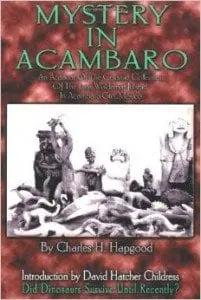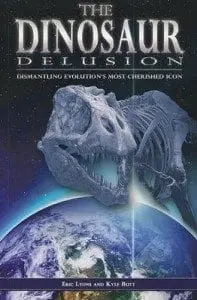Exposé #2: The Smithsonian Institution, and Charles DiPeso
In Exposé #1, we looked at the attempt by prominent atheist Richard Dawkins to censor, slander and blacklist agnostic science journalist Richard Milton. Here in Exposé #2 we turn the spotlight upon two parties: an icon of evolution, the Smithsonian Institution, and Charles DiPeso.
I have a question: if we were to find artifacts made by the people of ancient cultures who produced figurines, drawings, pottery, rock and stone engravings, etc., depicting realistic images of dinosaurs and other extinct animals, including anatomical features only discovered by modern archaeologists in the last 25 years, would this or would this not constitute very powerful evidence that those ancient peoples actually saw the dinosaurs depicted, and that those dinosaurs therefore lived in relatively recent times?
Such evidence actually does exist. It exists in vast abundance, and it exists all over the world. One such storehouse of evidence is the Waldemar Julsrud collection unearthed in the 1940’s and 1950’s and documented by Earle Stanley Gardner in his book, The Host with the Big Hat, and by Professor Charles H. Hapgood in his book “Mystery in Acámbaro,” which includes a lengthy introduction by David Hatcher Childress.
Charles Hapgood was not the only believer in the authenticity of the Acámbaro figurines. Hapgood also introduced the famous District Attorney-turned-novelist-and -television-writer, Earle Stanley Gardner to the figurines. Gardner was an attorney, and former District Attorney in Ventura County, CA. Gardner is most famous as the author of the Perry Mason novels. Gardner came to believe in the authenticity of the figurines after also personally investigating them.
Hapgood also introduced Ivan T. Sanderson to the figurines. Sanderson was a famous zoologist who was a frequent guest on Johnny Carson’s Tonight Show during the 1960’s. BOTH Sanderson and Gardner concluded that the figurines were authentic artifacts of the native, ice-age Chupicuaro culture as a result of their firsthand, eyewitness participation in the investigation of the figurines.
The Great Darwinian Propaganda Machine of our educational, media and government elite, predictably, are not very interested in spreading the word about these artifacts. In fact, it seems self-evident to me when you investigate this issue that they have routinely suppressed and censored such information from public view to the best of their ability and carried on a campaign of disinformation in the attempt to discredit the authenticity of the evidence–which evidence, in the Julsrud/Acámbaro case, under any other similar circumstances would be accepted at face value as the productions of the civilization being researched. But, No, say the evolutionists, the depictions are of dinosaurs and therefore the figurines MUST be frauds.
The only reason the authenticity of this evidence is disputed by evolutionists is precisely because of the nature of the depictions. The case in favor of the authenticity of the artifacts based upon all other considerations is overwhelming. One of the most compelling facts is that many of the dinosaurs depicted are of sauropods (like the famous brontosaurus, now renamed “brachiosaurus”) with dermal frills running down their backs. Now this is a most interesting detail because until 1992 sauropod dinosaurs were thought by scientists to be smooth-backed until Stephen Czerkas discovered fossilized skin impressions clearly revealing dermal frills. If the Acámbaro figurines are frauds, how did the perpetrators know 40 years in advance of these discoveries the correct anatomy of the dinosaurs depicted? I do not know of any evolutionist who has given any answer to that question with even a semblance of sanity.
This present article is not about this evidence per se, which is worthy of a study in its own right, but about the attempt of the Great Darwinian Propaganda Machine to suppress this evidence.
Exposé #2: The Smithsonian Institution, and Charles DiPeso
Background:
The small town of Acámbaro, Mexico, in the State of Guanajuato, 175 miles northwest of Mexico City, is the site of the ancient Chupicuaro culture. In 1944, Waldemar Julsrud, a German merchant and trained archaeologist who lived in Acámbaro, was riding on horseback on the outskirts of the town at the base of a mountain called El Toro when he came upon some figurines sticking out of an irrigation ditch. Julsrud excavated the figurines, and continued to excavate and collect the figurines for many years, and eventually amassed a staggering collection of over 33,500 artifacts of various styles and materials. The artifacts are obviously the work of many different people. Some 2,600 or so of the figurines collected are very clearly of dinosaurs, many of them depicting interaction with humans!
On a subject such as this, a picture is worth 10,000 words, and I strongly urge the reader to investigate the visual media documenting these finds. One of the best video presentations about the Acámbaro figurines is this one by geologist, Dr. Don Patton, who conducted his own extensive research of the figurines, and this site documenting the Acámbaro evidence and witnesses as to its authenticity, including the Mexican authorities.
Charles H. Hapgood, Harvard University graduate and Professor of history and anthropology at Keene State College of the University of New Hampshire, was an evolutionist and initially a skeptic about the figurines but came to believe in their authenticity after he did his own firsthand research. His book, Mystery in Acámbaro, is the product of 18 years of research. Hapgood concluded from his investigation of the Acámbaro figurines that the dinosaurs depicted did not die out 65 million years ago but persisted to recent times and were in fact seen alive by the people of the Chupicuaro culture who engraved their likenesses.
Needless to say, many of Hapgood’s fellow evolutionists cannot accept this conclusion. From the evolutionists’ perspective, the discovery of the existence of “living fossils” such as coelacanths swimming around in the Indian Ocean was bad enough. But dinosaurs 3,000 – 4,000 years ago in close contact with humans? No way!
According to Childress:
“Archaeological investigator John H. Tierney says Julsrud was discredited from the important 1923 discovery by a rival Acámbaro collector, who also tried to discredit the 1944 find. He apparently fed an American archaeologist named Charles DiPeso the story that an unlocatable family of peons had hoaxed Julsrud with the controversial artifacts…DiPeso claimed to have minutely examined the then 32,000 pieces within not more than four hours spent at the home of Julsrud. Tierney, who has lectured on the case for decades, points out that DiPeso would have had to inspect 133 pieces per minute steadily for four hours…(I)t would have required weeks merely to separate the massive jumble of exhibits and arrange them properly for a valid evaluation.” –pg. 15, Mystery in Acámbaro, emph. supp.
Charles DiPeso is the “authority” to whom the evolutionists routinely turn to debunk the Acámbaro finds. Yet DiPeso’s claims and argumentation are patently suspicious in multiple ways and full of holes. This is well-documented in the book The Dinosaur Delusion by Eric Lyons and Kyle Butt (see pages 77-98).
According to Childress:
“Tierney, who collaborated with the late Professor Hapgood, the late William N. Russell and others in the investigation, charges that the Smithsonian Institution and other archaeological authorities conducted a campaign of disinformation against the discoveries. The Smithsonian early in the controversy dismissed the entire Acámbaro collection as an elaborate hoax. Utilizing Freedom of Information Act approaches, Tierney discovered that practically the entirety of the Smithsonian’s Julsrud files are missing”!!!—pg. 16-17, Mystery in Acámbaro, emph. supp.
Yes. They would be missing, wouldn’t they? Having “lost” their files (!!!), the Smithsonian is in no position of authority to dismiss anything as a hoax. It seems rather clear to me, even if is not clear to evolutionists, that the reason the Julsrud files are missing from the Smithsonian Institution is because, as Childress says,
“The very existence of the figurines threatens the ivory tower of the current paradigm of history,” (pg. 20)
and so, rather than allow the information to go public, officers at the Smithsonian made sure the information disappeared. Why else would they hide or destroy the Julsrud files? Do not expect me to be naïve enough for even one second to believe that such files were lost or misplaced. This ought to be our operating assumption in this case unless and until the Smithsonian produces the long-missing files and proves otherwise.
In our next article, we shall examine a particularly egregious case of information repression on the part of evolutionists, regarding Carbon-14 dating of dinosaur remains.









